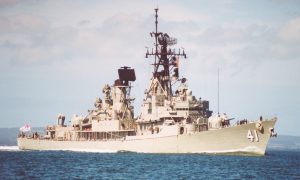- Author
- A.N. Other
- Subjects
- Ship histories and stories
- Tags
-
- RAN Ships
- HMAS Brisbane II, HMAS Perth II, HMAS Hobart II
- Publication
- March 2016 edition of the Naval Historical Review (all rights reserved)
By John Smith
A question was recently posed why hull number 40 is not used by HMA Ships. The DDGs Perth 38, Hobart 39 and Brisbane 41 are to be followed by the AWDs Hobart 39 and Brisbane 41.
This article deals with guided missile destroyer (DDG) pennant numbers, also known as hull numbers. More specifically it addresses the pennant number D41 of HMAS Brisbane.

The first two RAN DDGs, HMA Ships Perth and Hobart, were ordered in 1962 and were allocated by the RAN the pennant numbers D38 and D39 respectively for the reasons explained later. The third RAN DDG, HMAS Brisbane, was ordered later in 1963, her pennant number being D41. Why was it not D40?
Insofar as most of the Western Nations were concerned, post 1960 there were two principal authorities which assigned, but did not co-ordinate between them, the allocation of pennant numbers. They were the United States Navy and a loose coalition of NATO and Commonwealth Navies.
Looking firstly at the USN system, traditionally ships were numbered sequentially by type, e.g. battleships, cruisers, destroyers.
USS Gyatt, DD712, was commissioned as a Gearing class destroyer in 1945 and then in 1956 was converted to a DDG and became DDG712. As this was a new type of ship, her designation was changed in 1957 to DDG1. Gyatt was followed by the 23 USN Charles F Adams (CFA) class DDGs, DDG2 to DDG24 inclusive, the last of which was USS Waddellc ommissioned in 1964.
As the three RAN modified CFA class DDGs were ordered before the USN order was completed, the USN designated the RAN vessels as DDG25, 26 and 27. Soon afterwards, the West German Navy also ordered three modified CFA class DDGs and these were designated by the USN as DDG28, 29 and 30. Neither the RAN nor the FGN utilised these pennant numbers, nor were they subsequently reallocated to USN ships.
Rather than building a new DDG class after the CFAs, the USN decided to convert some of the Forrest Sherman, Mitscher, Hull and Coontz class vessels to DDGs and numbered them DDG 31 to 46 inclusive. Note that this includes DDGs 38, 39 and 41 which were the pennant numbers already allocated separately by the RAN to Perth, Hobart and Brisbane and commissioned as such.
Looking now to the other principal system for allocating pennant numbers, which came into force in about 1960, and was contained in a NATO publication Allied Communications Publication (ACP) No. 130, NATO Supplement 1, Section 2 titled ‘Decoding of visual callsigns (pennant numbers) allocated to Ships and to Certain Authorities of European NATO Countries and of the Countries of the British Commonwealth of Nations (excluding Canada)’. As the USN had its own system as already explained, their ships were also excluded from the publication. As from January 2012, the above supplement is now an integral part of NATO publication ACP 113 (AI) ‘Call Sign Book for Ships’ as Annex B. For information, it encompasses the following countries:
NATO – Belgium, Germany, Denmark, France, United Kingdom, Greece, Italy, HMAS Brisbane (DDG 41) RAN
Netherlands, Norway, Poland, Portugal, Spain and Turkey.
Commonwealth Nations – Australia, Kenya, Malaysia and New Zealand.
Perhaps surprisingly, Annex B is sponsored and co-ordinated by the Australian Department of Defence through the Directorate of Multinational Relations and Interoperability. This Annex does not differentiate between destroyers and DDGs. In it the RAN allocation of pennant numbers for destroyers in 2012 was as follows:
D08 spare
D38 spare
D39 HOBART
D40 spare
D41 BRISBANE
D42 SYDNEY
D57 to D59 spare
D109 to D162 spare
Although this system ensures that there will be no duplication of pennant numbers in types of ships of the participating countries, there will be duplication in numbers between, say, destroyers and frigates. Thus there could well be a D30 and a F30. As most navies do not have the type letter painted on the hull as well as the pennant number, there is the possibility of ships with the same number operating in company. Bearing in mind that the USN has its own system, there could have been, for example, a USN DDG, an RAN destroyer and a Spanish frigate all with the same hull number operating together.
It has been predicated by some that Brisbane was designated D41 and not D40 so that it would not duplicate the DDG40 pennant number of Coontz. However this theory is not agreed with. As explained earlier, USN ships were numbered in accordance with a different system to the RAN and Coontz was not designated as DDG40 until 1975, well after Brisbanewas commissioned. It would appear that there was no logical reason as to why Brisbane was therefore not designated D40 as this allocated to the RAN.
The answer would appear to be in an RAN file now archived away. Would that someone in Canberra with time to spare could search the archives to resolve this recurring issue! By the way, what happened to the Royal Canadian Navy in all of this? But that is another story.




